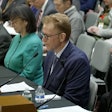Increased utilization of imaging services and the lingering shortage of radiologists -- coupled with declining reimbursement in the wake of the Deficit Reduction Act (DRA) of 2005 -- have made productivity a top priority at hospitals, imaging centers, and practices.
Earlier this decade, tracking productivity was not a big issue because of a surplus of radiologists. Today, however, the market has reversed, and radiology practices are looking to have the most qualified people on staff to meet the volume of images to interpret and not lose money to more efficient competitors.
What's the best way to track and evaluate a radiologist's or physician's productivity? The first step is to gather accurate and relevant performance data. "In the business of radiology, we need to be data-driven," said Fred Gaschen, executive vice president of Radiology Associates of Sacramento (RAS) in California. "You can't make good decisions on anecdotal data."
Gaschen described ways to measure radiologist productivity in a talk at the 2007 American Roentgen Ray Society (ARRS) meeting in May.
Rating by RVU
Because technology -- and medicine, in general -- changes so rapidly, Gaschen maintained that data that is one or two years old is no longer valid. External benchmarks often are neither reliable nor helpful, because each practice is unique.
RAS has its own internal evaluation process, relying heavily on relative value units (RVUs) to evaluate radiologist and physician productivity. RVUs "have a measurement on physician services that is correct and accurate," Gaschen said. "It is much more complex to understand and measure than time, money, or exams."
The concept of professional RVUs, which consist of technical and professional components, is to measure a radiologist's or physician's contribution to patient care. Gaschen recommends omitting the technical component from the evaluation and concentrating on the professional segment, which includes practical expenses, malpractice, and work factors.
"Work RVUs are consistent across the nation, they are published, and they are standard," he said. "Practice expense is modified by the wage indices in the region; malpractice is modified by the cost of malpractice in the region," making that data less useful for comparisons.
Daily measurements
RAS tracks its RVUs on a daily basis to fairly measure productivity among its staff. Say, for example, an annual review of one radiologist shows he or she is handling 15,000 RVUs per year, far outperforming his or her colleagues based on the annual numbers. Upon further evaluation, using daily performance, the practice discovers that the radiologist worked 35 more days than his or her counterparts.
"When you start normalizing the data to average daily RVUs, that radiologist may be at the bottom of the heap" in terms of productivity, Gaschen said.
To keep the RVU information relevant from year to year, past data also must be adjusted retroactively when RVU standards change. The old numbers then will match the revised RVUs and keep new measurements relevant.
The data from RVUs also can provide justification for additional staffing. Using an average of 11,000 RVUs per year for each radiologist, RAS monitors their performance and will notice if and when radiologists begin to surpass that number -- on an annualized basis -- over a period of several months.
If the radiologists are working at a rate of 11,400 RVUs per year, RAS knows to hire more staff, if it wants to keep the workload at 11,000.
Rating subspecialties
Gaschen also advises practices to consider subspecialty when evaluating productivity. "We look at our data by subspecialty, because it is inappropriate to compare a mammographer to a neuro doctor," Gaschen said. "If they are strictly doing mammography and neuro, the neuro doctor will come out significantly ahead every time."
Also, be aware of administrative time. Many larger groups require physicians to participate in contract negotiations and meet with hospital executives. Those hours or days should not be included when measuring a physicians' productivity. "Any administrative hours that are needed to run our practice and business are taken out of the physician denominator. Otherwise, the data will be skewed."
Tracking productivity is good for internal comparisons. Gaschen also recommends sharing the data with the staff on a quarterly basis, but making sure that the information is "blind," so a radiologist or physician is only aware of his or her individual performance.
Other criteria
Other metrics can be used track productivity, but Gaschen said there are some caveats and pitfalls. If exams and procedures are used to evaluate radiologists and physicians, he advises using CPT codes as the common denominator. "With a stereotactic breast biopsy, even though it has five CPT codes, some places count it as five procedures and one exam," he said. "It is difficult to do from that perspective. Most of the statistics count just CPT codes."
If billing is used as the criteria, Gaschen advises the use of gross charges. The use of net charges can become cumbersome, because different contract arrangements and payments can skew the numbers.
The number of hours worked is also an unreliable indicator because it combines productive time and nonproductive time, he believes.
By Wayne Forrest
AuntMinnie.com staff writer
June 12, 2007
Related Reading
Rad workload shows double-digit increase, September 22, 2005
Technology, technique help ease radiologist shortage, November 2, 2004
On getting a job in radiology: a primer for residents and fellows, October 18, 2004
Survey says rads are working harder for less, April 15, 2004
Survey predicts big loss of practitioners to retirement, changing work patterns, December 23, 2003
Copyright © 2007 AuntMinnie.com



















